Apple Mac mini Review (Mid 2010)
by Anand Lal Shimpi on August 9, 2010 3:37 AM ESTGeneral Performance
The original Mac mini was fast enough for the entry level Mac user back in 2005. Given that Apple’s iPad is fast enough for many users today, I don’t think it’s too difficult to understand that the 2010 Mac mini is sufficient for most needs.
There are two problems with the overall performance of the mini that will contribute to it feeling slow, particularly over time. The first is memory, and I’ll touch on this in more detail later, but 2GB of RAM is simply not sufficient for a computer running a heavyweight OS. Even light multitasking exposes this weakness. The second is the hard drive.
Apple ships the Mac mini with a 2.5” 5400RPM notebook drive. The drive keeps power consumption and noise down to a minimum, while being awful for performance. To Apple’s credit, OS X does a good job of caching frequently used data but without enough RAM this is a wobbly crutch.
The Mac mini is absolutely begging to have an SSD, and unlike the rest of Apple’s Mac lineup, one isn’t even offered on the mini. I’m going to take this opportunity to again plead for Apple to include a decent SSD in its customization options. These days the name of the game is SandForce. While that may change in another quarter or two, we still need Apple to take SSDs more seriously than it has been.
Now on to the numbers. I didn't have any previous generation Intel Mac minis on hand so the performance comparison is mainly to the MacBook/MacBook Pro. I did throw in some results from the early 2008 iMac I reviewed a while back.
General OS Performance
General OS usage is a difficult thing to quantify, but one measure of performance has always been the number of bounces an icon in the dock makes before an application loads. I decided to take it to the next level and write a quick script to launch 15 applications in a row, timing how long the entire process takes.
I launched, in order: Mail, Safari, Activity Monitor, iTunes, iCal, DVD Player, iPhoto, Photo Booth, Quicktime Player, Disk Utility, Preview, iMovie, Front Row, Garage Band and Aperture.
The entire process stresses both the disk and CPU, which is why we see a huge improvement when going to an SSD as well as differences between CPU speeds.
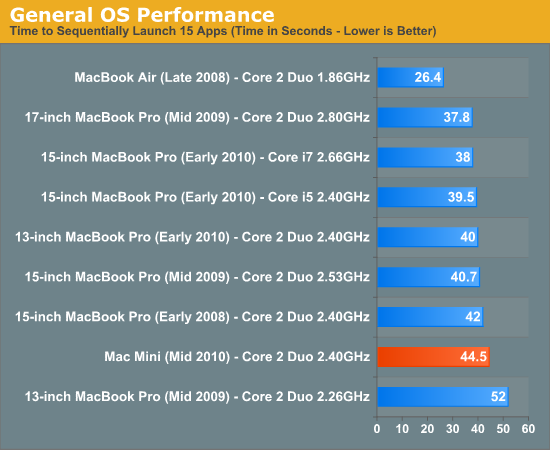
Application launch performance is slower than the 13-inch MacBook Pro because of the mini’s 2GB of memory. You’ll see this trend continuing as we go through our tests.
Adobe Photoshop CS4 Performance
The Retouch Artists Speed Test we use for our CPU testing under Windows also works under OS X. We're running the exact same benchmark here, basically performing a bunch of image manipulations and filters and timing the entire process.
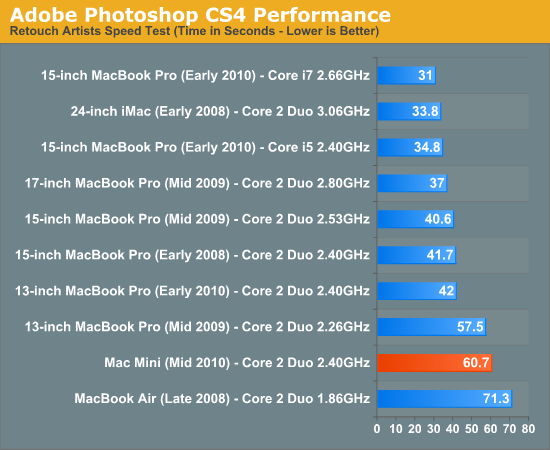
Photoshop performance is decent, but again behind the latest MBPs because we’re swapping to disk. Not only does the mini ship with 2GB of memory but it has to share 256MB with the GeForce 320M.
Aperture 2 RAW Import
For my Aperture test I simply timed how long it took to import 203 12MP RAW images into the library.
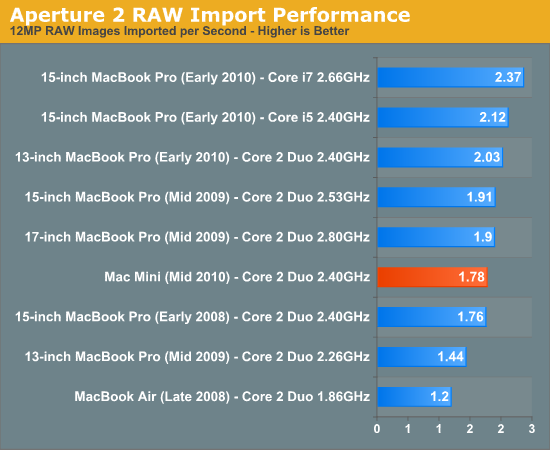
Our Aperture test is heavier on the I/O and thus narrows the gap between the 13-inch MBP and the mini.
Cinebench R10
I’m a fan of the Cinebench test because it lets me show off both single and multithreaded performance in the same workload. First, the single threaded performance:
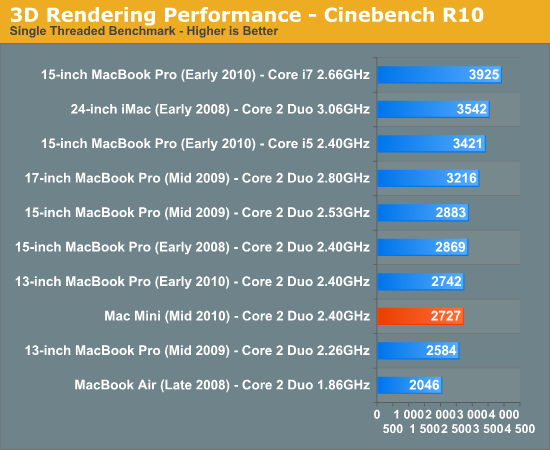

If we’re totally CPU bound, which is the case with Cinebench, you’ll see that the mini performs no differently than the 13-inch MacBook Pro. Compared to a mobile Core i5 you’re looking at roughly 70% of the performance. It’s fast enough, but not speedy.
Quicktime H.264 Video Encoding
Our final benchmark is more consumer focused. Here I'm taking an XviD and converting it to an iPhone-supported H.264 format.
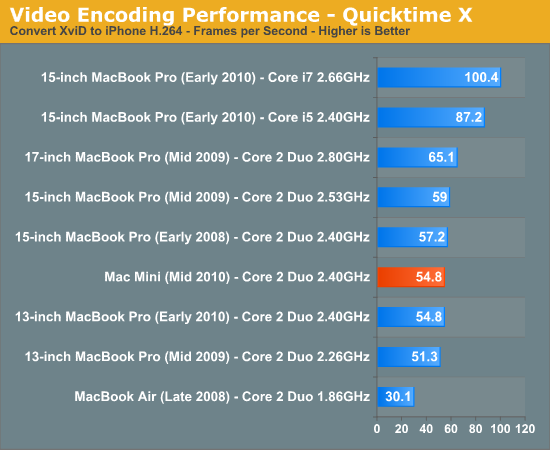
Video encoding performance is once again where we’d expect it to be, roughly on par with the 13-inch MacBook Pro. The new i5 systems are 60% faster.
Maintaining Profit Margins: 2GB vs. 4GB RAM
The $699 mini is the only Mac that currently ships with less than 4GB of memory (except for the MacBook Air). For a $700 system, that’s unacceptable. For a machine that’s sold in 2010, that’s unacceptable. For something that’s not a nettop, well, you get the idea.
The performance gain you see from just adding another 2GB of memory to the 2010 mini is huge. Here’s our Photoshop benchmark before and after an upgrade to 4GB:
| 2010 Mac mini Performance | ||||
| 2GB RAM | 4GB RAM | |||
| Photoshop CS4 Retouch Artists Bench | 60.7 seconds | 42.1 seconds | ||
| Cinebench R11.5 CPU | 1.38 points | 1.39 points | ||
That’s a 44% performance increase! The Cinebench results don't show a similar performance improvement since we're fully CPU bound in an test that easily fits in main memory.
You can argue that not all Mac mini owners won’t be running Photoshop, and I’d even agree with you there, but the memory limits come into play as soon as you start running a couple of large footprint applications. The multitasking falloff is sharp on the Mac mini because you only have 2GB of memory and you’ve got a dirt slow 5400RPM notebook hard drive in there.
The Photoshop results are just to show you something quantifiable. The user experience of the Mac mini is noticeably diminished by only having 2GB of memory.
Upgrading the memory is pretty simple. Just twist the pedestal on the bottom, remove the cover and swap sticks:
Apple ships the mini with 2 x 1GB sticks and the GeForce 320M has a dual-channel DDR3 memory controller so you’ll want to upgrade in pairs as well. Apple charges $100 for the upgrade, which isn’t too bad but you’re better off buying the memory yourself and just eBaying what you get with the system.
You just need to buy DDR3-1066 SO-DIMMs, the same thing you’d put in a notebook.










93 Comments
View All Comments
AstroGuardian - Monday, August 9, 2010 - link
Now we just sit and wait until some problems show up like overheating, melting of refurbished hard drives, security issues bla bla bla.... This starts to be a trend in Apple equipment..solipsism - Monday, August 9, 2010 - link
Curious, which new Macs use “refurbished” HDDs?Pirks - Monday, August 9, 2010 - link
Wintroll's ones, obviously.damianrobertjones - Tuesday, August 10, 2010 - link
He might use Ubuntu.Either way, he does have a point and the more people that defend Apple, the more they get away with things. Just look at End'Gadget.. many posts asked them to modify their review of the iPhone 4 but did they? Nope.
Oh well
Wizzdo - Monday, August 9, 2010 - link
Yup, troll above. With the wonderfully low power consumption I would imagine the Mini will be extremely dependable.damianrobertjones - Tuesday, August 10, 2010 - link
Probably, but remember, it's going to be mass produced so a few bad eggs will get in thereslb14 - Tuesday, August 10, 2010 - link
You must be confusing this with a Dell.Sorry, troll points are not awarded here.
Stokestack - Sunday, August 15, 2010 - link
"overheating, melting of refurbished hard drives, security issues bla"You're obviously desperate for attention. Why waste your time posting this instead of a legitimate point?
When it comes to the Mini, there's one glaring legitimate gripe: THE PRICE. It's a cool product, but grossly overpriced. It's mystifying why Apple bothers with it at this point. If they're overpricing it to avoid cannabilizing other sales, then why continue to make it?
They should've dropped the price by $200 and replaced the iTV with it. But again, that's counter to Apple's new goal: get rid of real computers and replace them all with locked-down devices running iOS. Again, why bother updating anything resembling a real computer in the product lineup? A smokescreen?
MySchizoBuddy - Monday, August 9, 2010 - link
an article about using 10+ mac mini for a render farm or HPC solution would be great.jasperjones - Monday, August 9, 2010 - link
now that wouldn't be exactly cost-effective ducy?